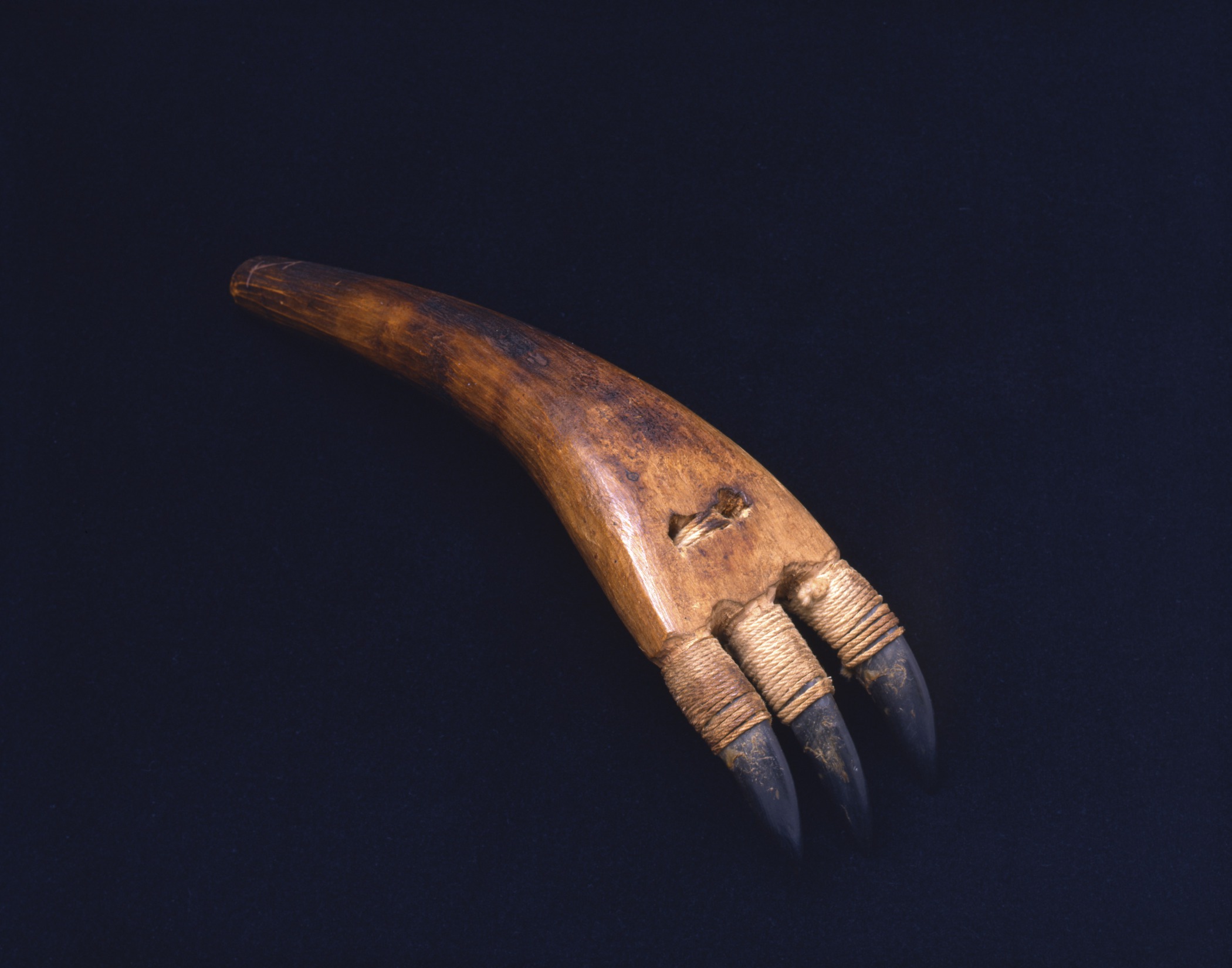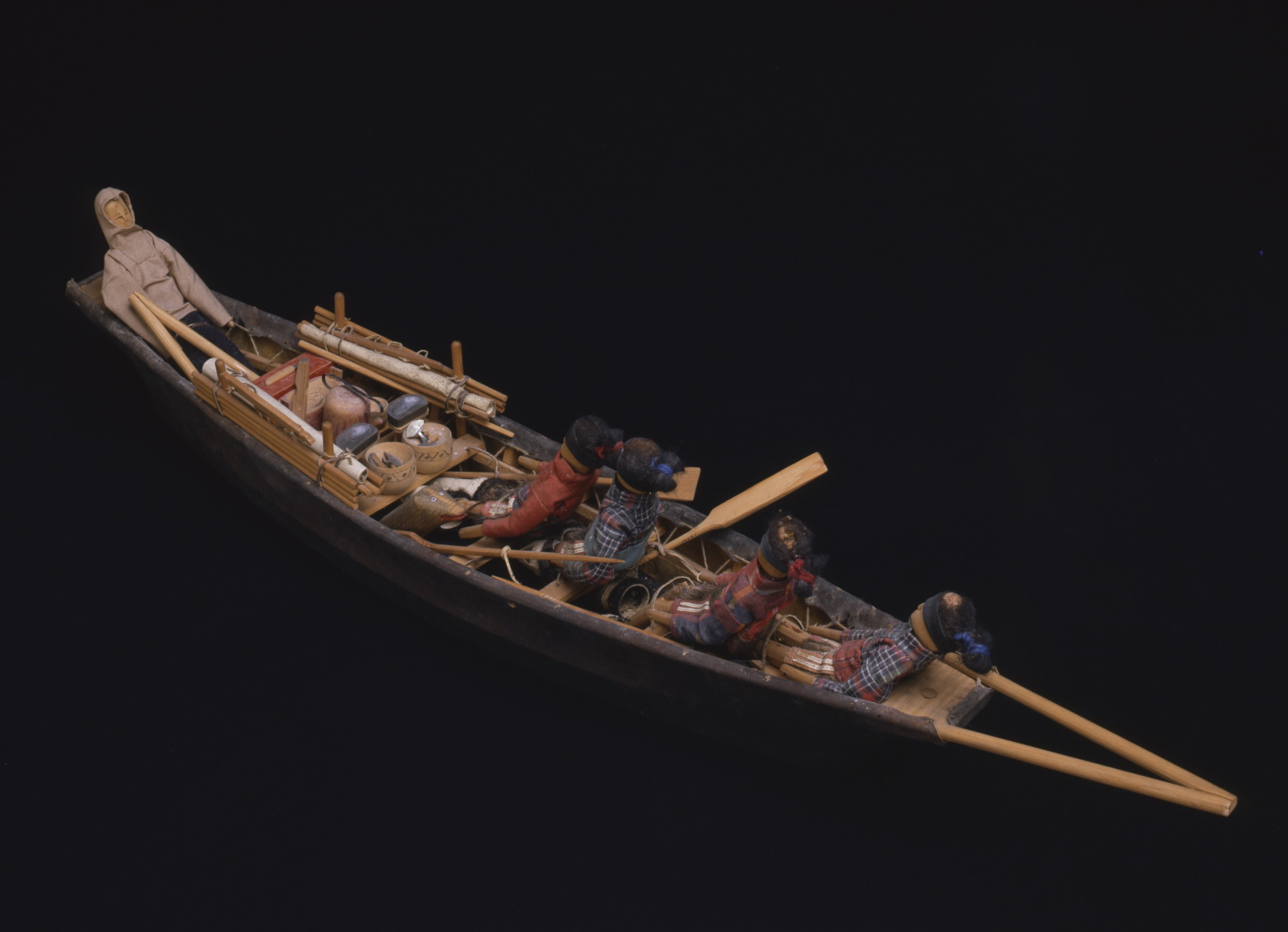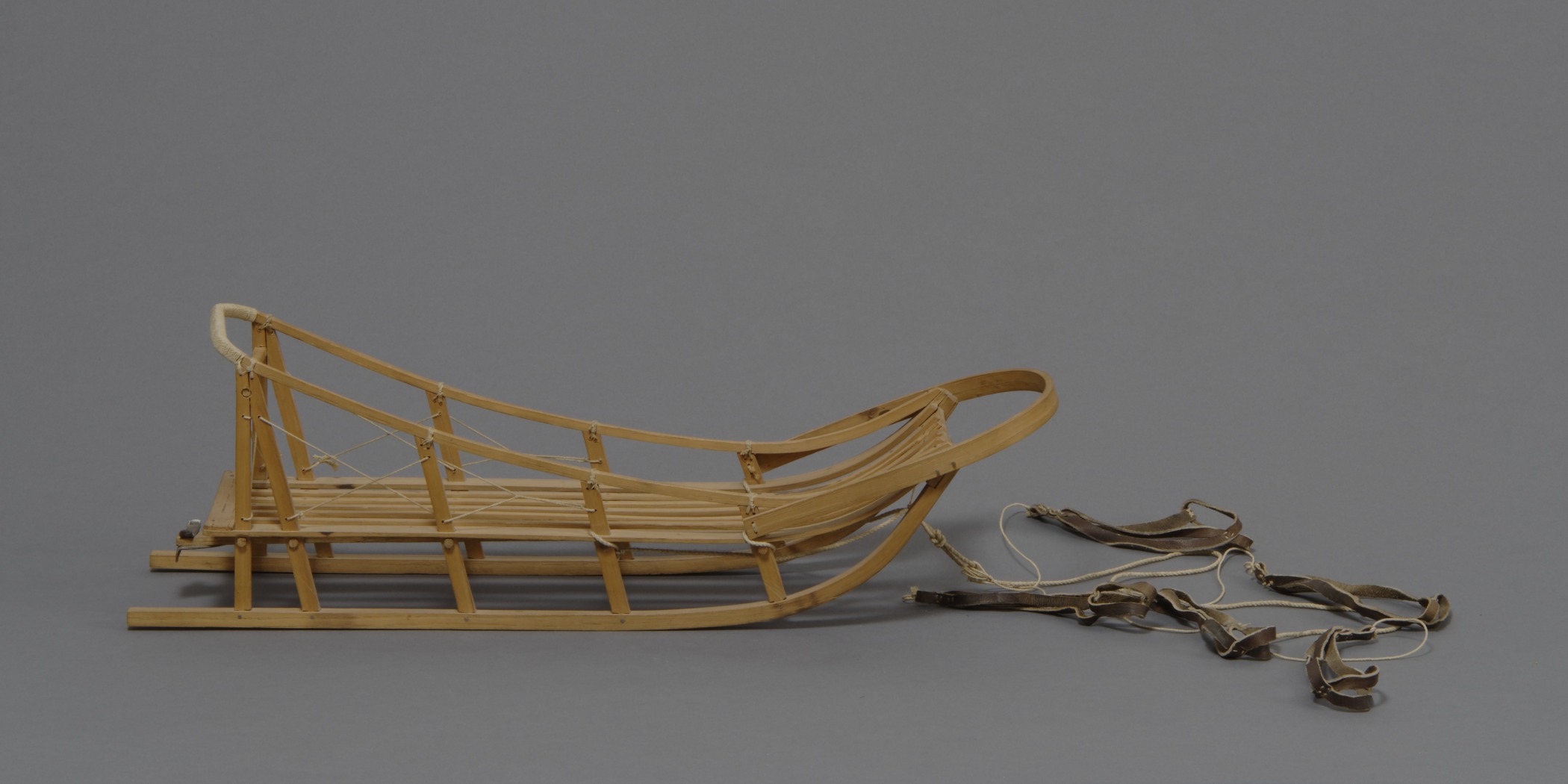Iñupiaq or Yup’ik
Ice scratcher
- Collected late 1930s
- Wood, seal claws, and twine
- 3 3/4 × approx. 9 in.
Hood Museum of Art, Dartmouth College: Gift of the Estate of Corey Ford, Class of 1921H; 169.75.24830
visibilityLook & DiscussThis tool was made to aid a seal hunter.
explore the object
Seals are mammals that need to come out of the water to breathe. This ice scratcher mimics the sound a seal makes when creating a breathing hole in the ice. When a hunter needed to approach a group of sunning seals, he would lie on the ice and hide behind a polar bear mitten or a white sealskin blind. To cover the noise of his approach as he crawled forward, he would scratch the surface of the ice with this tool. The soothing noise allowed him to get close enough to strike.
Arctic hunters traditionally made tools like this from driftwood or bone, sinew, and seal claws. This ice scratcher uses twine, a trade material, in place of sinew.
Related Objects
You can follow a hunter on a winter seal hunt through this series of sculptures and related tools in the Hood Museum of Art’s collection.
Lukasi Anangi Amamartua (Lucassie Amm), Canadian (Inuit), born 1935, Seated Man, Counting the Toes on His Right Foot, 1960. Soapstone, 5 7/8 × 4 3/4 × 3 1/8 in. Hood Museum of Art, Dartmouth College: Museum Purchase; 160.34.14538.
Akeeaktashuk, Canadian (Inuit), 1898–1954, Man in Parka Holding a Spear, about 1952. Serpentine, darkened with shoe polish, with plastic inlay, 8 3/4 × 5 1/8 × 2 15/16 in. Hood Museum of Art, Dartmouth College: Bequest of Evelyn Stefansson Nef; 2014.17.11.
An Inuit hunter counts the toes on his right food, a custom to guess if he will capture a seal. What can you tell about the importance of the outcome of this game by looking carefully at the figure’s expression?
A hunter stands poised above a breathing hole in the ice. As mammals, seals need to come up out of the water for air. When a seal emerges, the hunter must act quickly to harpoon the seal before it swims away.
Canadian (Inuit), Hunting a Seal, early 1950s. Steatite and ivory, 3 3/4 × 3 7/16 in. Hood Museum of Art, Dartmouth College: Gift of Louise Potter; 171.46.25265.
Canadian (Inuit), An Inuk Pulling a Seal out of the Water, about 1955. Steatite and felt , 9 7/16 × 4 9/16 × 6 7/16 in. Hood Museum of Art, Dartmouth College: Gift of Willy E. Gorrissen; 179.17.25857.
A successful hunter leans back on the ice and pulls on a line attached to a seal he has caught through a breathing hole. How can you tell the seal is quite heavy?
A hunter lifts a seal out of the water. Success! Images of hunting from the Arctic reflect the close relationship between people and animals. This hunter may be thanking the animal for allowing itself to be caught so that he can feed his family.
Iñupiaq, seal drag with a carved and engraved handle depicting a seal, collected 1905. Ivory and rawhide, 4 1/8 × 13/16 × 9/16 in. Hood Museum of Art, Dartmouth College: Bequest of Frank C. and Clara G. Churchill; 46.17.9651.
In order to tow a freshly killed seal over the snow, a hunter would use a tool known as a seal drag. The line of the seal drag connected the hunter to the animal both literally and spiritually. The ivory handle was carved in the form of a seal to honor the seal and thank it for its sacrifice.
Iñupiaq, seal drag with a carved and engraved handle depicting a seal, collected 1905. Ivory and rawhide, 4 1/8 × 13/16 × 9/16 in. Hood Museum of Art, Dartmouth College: Bequest of Frank C. and Clara G. Churchill; 46.17.9651.
Sometimes seals rest on the surface of the ice and snow and bask in the sun. All of the Inuit sculptors whose work is represented in this resource were also hunters. The ability to provide for their families relied on careful observation and an intimate understanding of the animals they pursued. As a result, their sculptures wonderfully capture the personality and unique qualities of each animal.
Canadian (Inuit), Inuk Creeping on His Belly to Surprise a Seal Basking on the Ice, about 1955. Steatite, 2 × 3 1/16 × 4 7/8 in. Hood Museum of Art, Dartmouth College: Gift of Willy E. Gorrissen; 179.17.25856.
In this sculpture, a hunter sneaks up on a seal resting on the ice. Sometimes hunters hid behind large white sealskin or polar bear skin mittens for camouflage.
You can also explore aspects of traditional seal hunting through the Hood’s collection of models. Adult men made models for young boys to encourage them to practice the skills they would need one day as hunters, and also for outsiders interested in the lives of Arctic people.
Kalaallit (West Greenlandic Inuit), Souvenir Model Kayak with Paddler and Equipment for Seal Hunting, collected 1950. Wood, seal skin, gut (intestines), bone, and steel, 1 1/2 x 1 15/16 x 23 1/4 in., Hood Museum of Art, Dartmouth College: Gift of Peter S. Dow, Thayer School, Class of 1911; 50.14.12412
This model kayak was created for trade by a Kalaallit artist from Greenland. It recreates, with astonishing detail, some of the equipment necessary for a seal hunt.
He wears a furless, sealskin parka, and carries with him all the tools he will need for seal hunting, including: 1 double-ended paddle tipped with bone, 1 lance with steel tip, 1 bird spear with steel tip and bone prongs, 2 harpoons with bone tips (one with throwing board), 1 lance with bone tip, 1 seal bladder, 1 bone knife, and a line coiler or line rack.
A seal bladder is an organ taken from a seal, washed and dried, filled with air, and attached to a harpoon line. When a swimming seal is harpooned, the bladder on the rope drags in the water, tiring the seal and helping the hunter locate and capture it.
Kalaallit (West Greenlandic Inuit), souvenir model of a man seal hunting in the spring using a blind and a gun stand, early 1930s. Wood, paper, cloth, seal fur, sealskin, commercial thread, and glue, 2 9/16 × 3 3/4 × 22 13/16 in. Hood Museum of Art, Dartmouth College: Gift of George Murphy, Class of 1941; 39.70.7906.
Since the nineteenth century, indigenous hunters have used guns for seal hunting. In this model, a Kalaallit hunter props his gun on a stand behind a blind, a piece of white fabric that would blend with the snow, in order to get close enough to shoot the seal.
Learn More
In this video, Museum Specialist Dawn Biddeson describes tools used for hunting in the Hood Museum of Art's collection.




